#global agriculture
Explore tagged Tumblr posts
Text
"Marginal improvements to agricultural soils around the world would store enough carbon to keep the world within 1.5C of global heating, new research suggests.
Farming techniques that improve long-term fertility and yields can also help to store more carbon in soils but are often ignored in favor of intensive techniques using large amounts of artificial fertilizer, much of it wasted, that can increase greenhouse gas emissions.
Using better farming techniques to store 1 percent more carbon in about half of the world’s agricultural soils would be enough to absorb about 31 gigatons of carbon dioxide a year, according to new data. That amount is not far off the 32 gigaton gap between current planned emissions reduction globally per year and the amount of carbon that must be cut by 2030 to stay within 1.5C.
The estimates were carried out by Jacqueline McGlade, the former chief scientist at the UN environment program and former executive director of the European Environment Agency. She found that storing more carbon in the top 30 centimeters of agricultural soils would be feasible in many regions where soils are currently degraded.
McGlade now leads a commercial organization that sells soil data to farmers. Downforce Technologies uses publicly available global data, satellite images, and lidar to assess in detail how much carbon is stored in soils, which can now be done down to the level of individual fields.
“Outside the farming sector, people do not understand how important soils are to the climate,” said McGlade. “Changing farming could make soils carbon negative, making them absorb carbon, and reducing the cost of farming.”
She said farmers could face a short-term cost while they changed their methods, away from the overuse of artificial fertilizer, but after a transition period of two to three years their yields would improve and their soils would be much healthier...
Arable farmers could sequester more carbon within their soils by changing their crop rotation, planting cover crops such as clover, or using direct drilling, which allows crops to be planted without the need for ploughing. Livestock farmers could improve their soils by growing more native grasses.
Hedgerows also help to sequester carbon in the soil, because they have large underground networks of mycorrhizal fungi and microbes that can extend meters into the field. Farmers have spent decades removing hedgerows to make intensive farming easier, but restoring them, and maintaining existing hedgerows, would improve biodiversity, reduce the erosion of topsoil, and help to stop harmful agricultural runoff, which is a key polluter of rivers."
-via The Grist, July 8, 2023
#agriculture#sustainable agriculture#sustainability#carbon emissions#carbon sequestration#livestock#farming#regenerative farming#native plants#ecosystems#global warming#climate change#good news#hope
4K notes
·
View notes
Text
Hubert Reeves once wrote that "on the cosmic scale, liquid water is rarer than gold". And what is true for the universe is even truer in the Sahel, the name given to the vast, arid belt that skirts the Sahara and stretches across Africa from east to west. Since 3,000 BCE, the peoples of this region have invested tremendous effort into coming up with myriad ways to capture and control this remarkably scarce resource. Faced with the poor distribution of water across space and time, they have had to resort to intelligent, thrifty methods to make the most of even the tiniest drop. Overlooked for many years, the secrets of the Sahelian landscape are starting to pique the interest of researchers and decision-makers.
Continue Reading.
813 notes
·
View notes
Text
The Nature Conservancy is leading the Expanding Agroforestry Project to provide training, planning and funds for 12,140 hectares (30,000 acres) of new agroforestry plantings in the U.S.
Goals for the program include enrolling at least 200 farmers, with a minimum of 50 from underserved communities.
Initial applications have surpassed expectations — 213 farmers applied in the first cycle with 93% coming from underserved populations.
The first round of payments is set for distribution in fall 2024.
#good news#agroforestry#agriculture#environmentalism#farming#environment#global climate change#climate crisis#climate change#usa
177 notes
·
View notes
Text
As the H5N1 avian influenza virus continues its rampage through U.S. dairy cow herds, it has also infected human farm workers. A different strain has also infected workers on poultry farms, most recently in Washington State. On Wednesday the U.S. Department of Agriculture announced that the virus had been detected in a pig for the first time at a farm in Oregon. Now, as the usual seasonal flu season approaches, some health experts wonder if it might give bird flu a dangerous boost.
46 notes
·
View notes
Text
(subtitles are autogenerated and are not particularly accurate)
🇮🇳 🚜 🚨
MASSIVE FARMER'S PROTESTS OUTSIDE INDIAN CAPITAL AND ACROSS THE NORTH OF THE COUNTRY
📹 Massive protests are confronted with teargas, armed police with rubber bullets and drones as thousands of farmers, mostly in India's northern Punjab region, protest on Tuesday demanding a Minimum Support Price or MSP for all crops to raise farmer's income.
Dozens of Farmer's unions participated in the strikes, calling for a "Delhi Chalo" or March to Delhi.
Police in and around the capital have erected barriers on highways surrounding New Delhi, and have begun firing tear gas and rubber bullets at the approaching farmers.
Tractors, along with thousands of farm hands, are seen in footage nearing the outskirts of New Delhi, in the northern Haryana state, being confronted by officers with gas and smoke bombs, including some dropped from buzzing drones overhead.
Authorities have shut down Internet services in some areas where protestors approach, and have erected concrete roadblocks and barriers, while local officials have banned public gatherings and are deploying extra security personnel.
Officials in New Delhi emphasized that sufficient police and paramilitary personnel have been deployed to all entry points to the city.
Farmers are demanding dozens of changes, including a new MSP or floor price for crops to increase and guarantee farmer income, as well as a full debit waiver, according to local union officials.
Political officials in New Delhi say they're open to talks, with Agriculture Minister, Arjun Munda telling reporters on Tuesday that the Federal government already is "bound to protect the interest of farmers."
"Farmers also need to understand that inconvenience shouldn’t be caused to the public,” Minister Munda said, adding the government was always ready for negotiations with the Farmer's unions.
“We are ready to do everything possible to find a solution to this issue,” he said.
#source
#videosource
@WorkerSolidarityNews
#india#indian farmers protests#farmers protest#india farmer protest#minimum support price#farmers#farmer unions#unions#labor unions#india news#indian politics#indian news#india protests#indian unions#agriculture#politics#news#geopolitics#world news#global news#international news#breaking news#current events#asia#south asia#india protest#agricultural workers#workers#labor movement
70 notes
·
View notes
Text
Ya know how I know that climate change is fucking shit up?
It's not just the obviously worse natural disasters.
Or the warm winters with no snow.
It's that the bush in front of my house was still flowering when it started losing leaves. There was no time for it to go through it's whole cycle. Because it's fucked up. So instead of leaves falling off the bush, it's dead flowers.
12 notes
·
View notes
Text
It’s rather lonely being the only one in your little freak corner of hyperfixations
#Cornish history specifically shipping trade/tin and copper mining/agriculture/language then and now#not really something I can get other folk involved with#save the odd shipwreck#but liiiiiike#I care I care so much#I once cried when I found some coal on a walk#I will and have taken people to the mat who called Kernowek ‘not a real language’#I care about the local history and the impact on a global scale#I!!! NEED!!! BUDDIES!!!!!!
9 notes
·
View notes
Text
IT HAS PRATICALLY NOT RAINED IN 2 FUCKING YEARS IN FRENCH PYRENEES ???????? 😨 holy christ I had no idea it was that bad !!!
the article is in french but here's a translated part to share how bad things are getting there :
"With only 153 millimetres of rain over the last five months, the departement has recorded a precipitation deficit of almost 60%, according to Météo France. This winter drought "worthy of the end of August", according to the public agency, has plunged orchards and vineyards into a state of intense water stress, while groundwater tables are at their lowest. Recent heat records - 25.6°C in Perpignan on February 4 - have not helped matters. During the winter, the trees go into vegetative rest," recalls the winemaker. Except that for an apricot tree to rest, it takes eight hundred hours at less than 8°C. That's a long way off. Without rain within six months, "everything's dead", he prophesies. And that's not an exaggeration: even before these two hot, arid years, the 20,000 hectares of vines in the Pyrénées-Orientales region were in structural crisis, and climate change had already caused yields to plummet."
#climate emergency#france#climate change#drought#global warming#agriculture#wine#bee tries to talk#upthebaguette#french side of tumblr
19 notes
·
View notes
Text





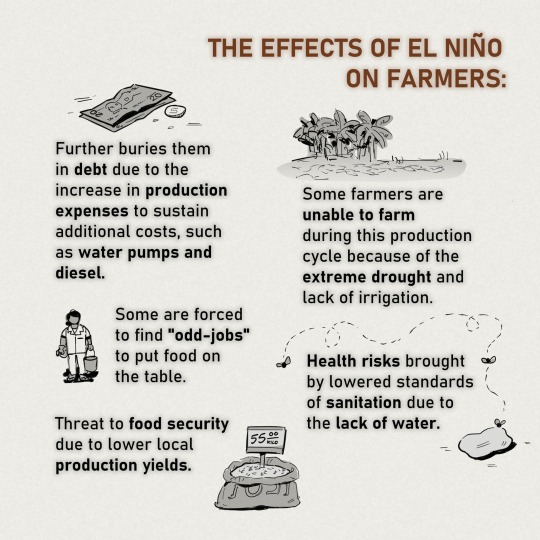
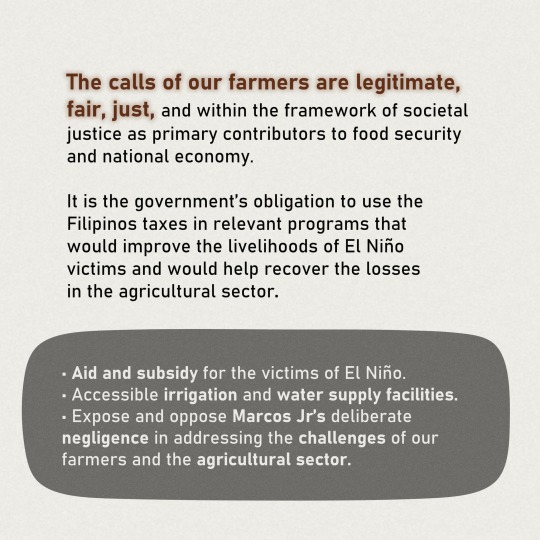
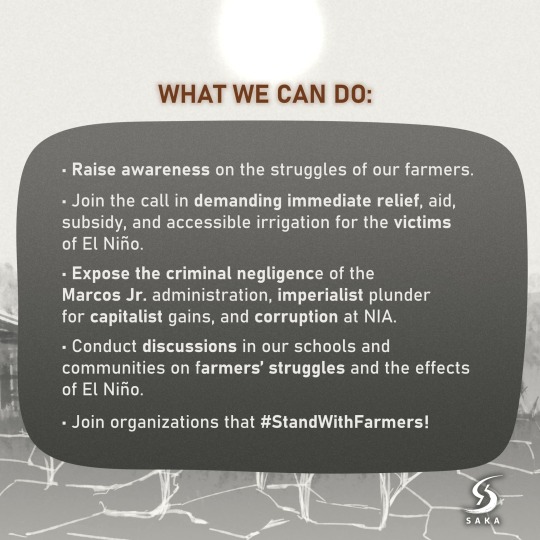
via SAKA Facebook page
#el nino#philippines#philippine politics#politics#climate change#global warming#ferdinand marcos#marcos#bbm#environment#agriculture
11 notes
·
View notes
Text
"Although methane is harmful in its effect on our climate, a new study of the greenhouse gas shows that its effects are not as intense as previously thought.
The biggest sources of methane gas emissions come from coal, oil, and gas development, although emissions from agriculture is probably the most heavily publicized.
As the planet absorbs heat from the sun, it would naturally radiate this long-wave energy back out into space. But greenhouse gasses trap the heat inside the atmosphere, causing ‘the greenhouse effect’.
Scientists at the University of California-Riverside have now found that methane also absorbs short-wave energy, which, through the creation of cooling clouds, actually cancels 30% of its own heat (the heat which the gas has created in the greenhouse effect).
Specifically, it creates more low-level clouds that offset the short-wave energy from the sun and fewer high-level clouds which increase the outward radiation of long-wave energy from the Earth.
“This has implications for understanding in more detail how methane and perhaps other greenhouses gases can impact the climate system,” said Robert Allen, UCR assistant professor of Earth sciences. “Shortwave absorption softens the overall warming and rain-increasing effects but does not eradicate them at all.”
They also found, as Allen says, that methane cancels 60% of increased levels of precipitation predicted under global warming models—yet more good news for cities and towns around flood zones.
For a number of reasons, this could be a revolutionary discovery. The EPA says that methane’s greenhouse effect is 34 times that of CO2.
Using the U.S. as an example, methane accounts for only around 10% of the nation’s emissions. The lifespan of a methane molecule in terms of its harmful affect on climate is around 9 years.
This means that methane emitted 9 years ago is no longer causing a greenhouse effect. By contrast, the greenhouse effect of CO2 molecules is more than 1,000 years.
For years, climate scientists have known that methane was a critical greenhouse gas for humanity to target, but now we can create more accurate models that reflect how methane is 30% less harmful than we thought and it counteracts 60% of its own harmful rain effects."
-via Good News Network, 3/28/23
The study was published in the renowned journal Nature, and there's a full open access copy here!
#global warming#climate change#emissions#methane#greenhouse gasses#greenhouse gas emissions#nature#agriculture#atmospheric science#carbon dioxide#good news#hope#science and technology
165 notes
·
View notes
Text
Strawberries could be fewer and more expensive because of higher temperatures caused by climate change, according to research from the University of Waterloo. Using a new method of analysis, the researchers found that a rise in temperature of 3 degrees Fahrenheit could reduce strawberry yields by up to 40%. Canada is a major importer of strawberries from California. In 2022, Canadian imports of strawberries from California were worth US$322.8 million. "This research shows how climate change can directly impact the foods we love, emphasizing the importance of sustainable farming practices to maintain a stable food supply for everyone," said Dr. Poornima Unnikrishnan, a postdoctoral fellow in the Department of Systems Design Engineering at Waterloo.
Continue Reading.
119 notes
·
View notes
Text
Man I'm vegan for the animals obviously but at this point it's almost more important to me for the environmental impact
#animal agriculture is one of the largest contributors to climate change and deforestation#it's undeniable and the fact that so many people refuse to do anything bc 'its corporations doing global warming'#WHO IS SUPPLYING THE DEMAND#if there was a reduction in demand they wouldn't supply#it feels like I'm going insane sometimes#w34ry words
2 notes
·
View notes
Text

🇨🇳
CHINA'S NEW FOOD SECURITY LAW IS A MOVE IN THE RIGHT DIRECTION, EVEN AS THE U.S. HANDS OVER ITS OWN AGRICULTURAL SOVEREIGNTY TO CORPORATIONS
China's National legislature passed a new food security Law Friday, aimed at securing its national food supply and reducing waste in food production in a country that feeds more than 1.4 billion people with less than 9% of the world's arable land.
At the very time when the United States is handing over it's agricultural sovereignty to giant multi-national corporations (including ones from China), China is moving in the opposite direction, looking to secure food supplies and exercise public ownership of agricultural lands.
China's Xinhua News Agency writes that the new food security Law stipulates that China must "'ensure absolute security in staple foods and basic self-sufficiency in grains,' indicating that the country must ensure that its food supply remains firmly in its own hands."
The new Law was passed by China's legislature at a session of the National People's Congress (NPC) Standing Committee on Friday, with the law taking effect on June 1st, 2024.
According to Xinhua, the law further stipulates that the "state shall restrict the occupation of farmland and the conversion of farmland to other forms of land use, such as forests and grassland."
The Law also emphasizes the establishment of a National agricultural germplasm resource bank, improvement of the national system for cultivating superior crop varieties, as well as promoting mechanization and building capacity for disaster prevention, mitigation and relief in grain production.
The Law also introduces measures to raise the income of farmers who grow crops.
According to Xinhua, China has produced a grain harvest of over 650 million tons for nine consecutive years, with a staple-food self-sufficiency rate above 100% and a grain-sufficiency rate above 95%.
The Law also contains a chapter dedicated specifically to food conservation, and creates enforcement mechanisms to reduce food waste from production to consumption.
Provisions also cover issues such as those concerning grain reserves, distribution, processing, and emergency response.
Xinhua says the new legislation on food security is "of great importance", and "lays a solid legal foundation for advancing China's system and capacity for food security governance, said Wang Zhimin, a member of the NPC Standing Committee."
#source
@WorkerSolidarityNews
#food sovereignty#agriculture#agricultural sovereignty#united states#analysis#political analysis#china#china news#us news#us agriculture#china agriculture#chinese food security#food security#us food security#politics#news#geopolitics#world news#global news#international news#breaking news#current events#political opinion#agriculture news#agricultural news#global agriculture#grain production#china grain production#us corporatism#corporatism
20 notes
·
View notes
Text
Sustainable Agriculture Practices That Are Reducing Global Carbon Emissions

As the world seeks to combat climate change, agriculture plays a key role in either contributing to or mitigating greenhouse gas (GHG) emissions. Modern, intensive farming practices are responsible for a significant portion of global emissions, but sustainable agricultural practices can offer solutions to reduce carbon emissions and help achieve climate goals. In this article, we’ll explore some of the most impactful methods farmers are adopting to reduce their carbon footprint while ensuring food security.
Regenerative Agriculture: Restoring Soil Health and Sequestering Carbon
One of the most promising approaches in sustainable farming is regenerative agriculture, which focuses on restoring soil health and increasing biodiversity. This method involves practices such as cover cropping, crop rotation, and reduced tillage. By keeping the soil covered with plants year-round and minimizing soil disturbance, regenerative agriculture increases the soil's ability to store carbon, enhancing soil fertility and reducing the need for synthetic fertilizers.
Farmers who implement regenerative practices often see healthier soils, which act as a natural carbon sink, pulling carbon dioxide from the atmosphere and storing it in the ground. In turn, these healthier soils improve water retention, reduce erosion, and promote greater biodiversity, creating a more resilient farming ecosystem. This is critical for combating climate change, as healthy soils can sequester significant amounts of carbon over time.
Agroforestry: Integrating Trees into Farmland
Agroforestry is another key sustainable practice that helps reduce carbon emissions. This method involves planting trees and shrubs alongside crops or integrating them into livestock systems. The trees absorb carbon dioxide as they grow, acting as long-term carbon storage, while also providing shade, reducing soil erosion, and increasing biodiversity on the farm.
By combining trees with crops, agroforestry creates a balanced ecosystem that supports both plant and animal life. The trees also help regulate local climates, provide additional income streams from timber or fruit production, and improve soil structure. As an added benefit, agroforestry systems are more resilient to climate shocks such as droughts and floods.
Conservation Tillage: Minimizing Soil Disturbance
Traditional farming methods often involve tilling the soil to prepare for planting. However, this process can release large amounts of carbon stored in the soil into the atmosphere. Conservation tillage practices, such as no-till or reduced-till farming, minimize this disturbance, keeping more carbon in the soil.
By reducing or eliminating tillage, farmers can preserve soil structure and prevent carbon loss. Additionally, no-till farming increases water infiltration and reduces the need for synthetic fertilizers and pesticides, further cutting down on GHG emissions. These practices are especially useful in areas prone to erosion, where soil health is critical for long-term agricultural success.
Integrated Pest Management (IPM): Reducing Chemical Use
Integrated Pest Management (IPM) is a sustainable approach that reduces the reliance on synthetic pesticides and fertilizers. This practice involves using biological controls, crop rotation, and resistant crop varieties to manage pests and diseases naturally. By cutting down on chemical inputs, farmers can lower their overall carbon footprint, as the production and application of pesticides and fertilizers are major sources of GHG emissions in conventional agriculture.
IPM also promotes healthier ecosystems by protecting beneficial insects, improving soil health, and reducing the risk of pesticide runoff into waterways. With fewer chemicals in the environment, biodiversity is preserved, and farms become more resilient to pests over time.
Precision Agriculture: Using Technology to Optimize Resources
Precision agriculture employs modern technology to optimize the use of resources such as water, fertilizer, and pesticides. GPS-guided equipment, soil sensors, and drones allow farmers to apply inputs more efficiently, ensuring that crops receive exactly what they need without waste. This method not only improves crop yields but also significantly reduces the overuse of chemicals and water, both of which contribute to carbon emissions.
By using data-driven insights, precision agriculture allows for more targeted interventions, which means less energy is required to grow crops, and fewer emissions are produced. The result is a more efficient and sustainable agricultural system.
Carbon Farming: Capturing and Storing Carbon
Carbon farming is a technique that focuses explicitly on sequestering carbon in soils through improved agricultural practices. This involves planting cover crops, rotating crops, and using organic fertilizers, all of which increase the organic matter in the soil. The added organic matter boosts the soil's ability to retain carbon, thus reducing the amount of CO₂ in the atmosphere.
Farmers participating in carbon farming can even receive incentives or carbon credits for their efforts, creating an additional economic benefit. As more farmers adopt these practices, the potential to store vast amounts of carbon in agricultural soils increases, helping to mitigate climate change on a global scale.
Improved Livestock Management
Livestock farming is a significant contributor to methane emissions, one of the most potent greenhouse gases. However, improved livestock management practices can help reduce emissions from this sector. Strategies such as rotational grazing, which involves moving livestock between pastures to prevent overgrazing, can improve soil health and sequester carbon.
Additionally, dietary supplements for livestock, such as seaweed-based additives, have been shown to reduce methane emissions from digestion. These innovations, combined with better manure management practices, can significantly lower the carbon footprint of livestock farming.
Key Sustainable Agriculture Practices Reducing Carbon Emissions
Regenerative agriculture to improve soil health and carbon sequestration
Agroforestry to integrate trees and reduce emissions
Conservation tillage to minimize soil disturbance
Precision agriculture for optimized resource use
Carbon farming for increased soil carbon storage
Integrated pest management to reduce chemical use
Improved livestock management to cut methane emissions
In Conclusion
Sustainable agriculture is essential in the global effort to reduce carbon emissions and combat climate change. From regenerative practices that enrich the soil to precision farming that minimizes waste, these methods offer a pathway toward a more sustainable, resilient food system. By adopting these practices on a global scale, agriculture can shift from being a major contributor to climate change to a key player in the solution.
4 notes
·
View notes
Text
The Future of Wheat Farming in Kenya: The Economic Benefits of Israeli-Kenyan Wheat Farming Partnerships
“Explore the potential transformation of Kenya’s wheat farming through Israeli investment, focusing on innovative technologies and private partnerships to boost production and create jobs.” “Learn how Israeli investors are set to revolutionize wheat farming in Kenya, enhancing food security and leveraging advanced agricultural technologies in private-sector partnerships.” “Discover the future of…
#agricultural growth#agricultural investment#agricultural modernization#agricultural partnerships#arable land#drone farming#farming innovation#Farming technology#food prices#Food security#global wheat supply#Israeli investors#Israeli technology#job creation#Kenya Agriculture#Kenya food production.#Kenya wheat farming#Kenya-Israel collaboration#precision agriculture#private partnerships#private sector investment#sustainable farming#wheat farming#wheat production#wheat supply chain
2 notes
·
View notes
Text
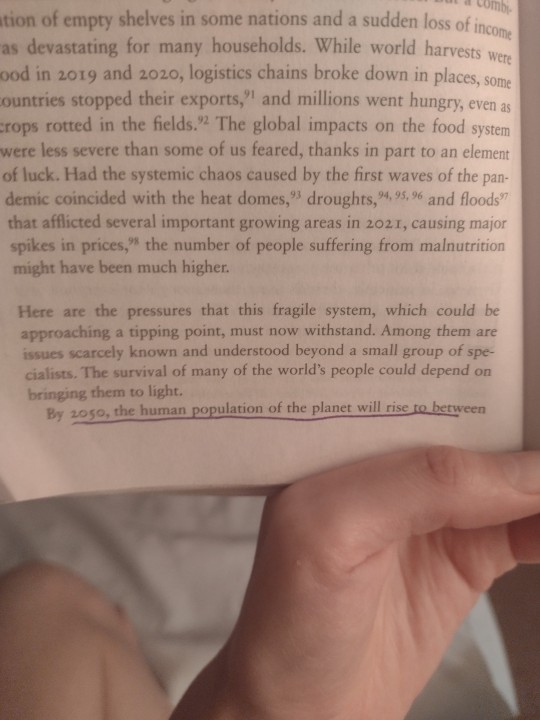
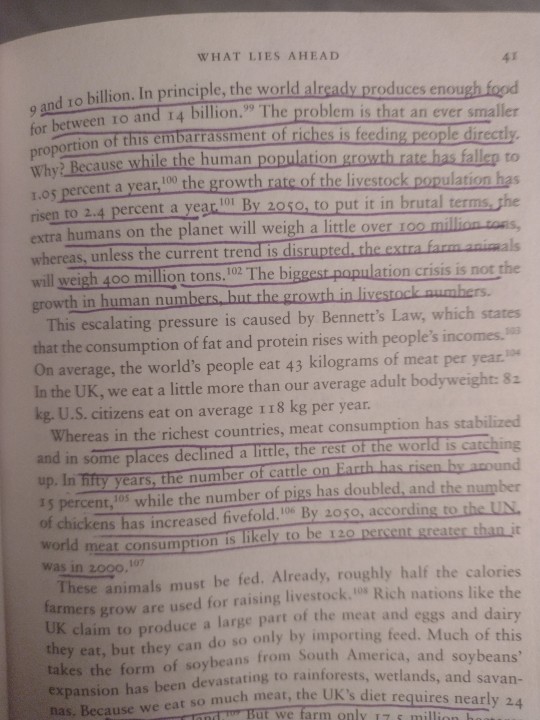

From Regenesis: Feeding the World Without Devouring the Planet by George Monbiot
24 notes
·
View notes